Last edit by: IB Advertising
See related guides and technical advice from our community experts:
Browse all: Engine and Powertrain
- Honda Accord: How to Recharge your AC System
Step by step instructions for do-it-yourself repairs.
Browse all: Engine and Powertrain
How to evacuate and recharge your R134a a/c system.
#1
This is an instructional thread for how to evacuate and recharge your air conditioning system after repairs that require the system to be opened to the atmosphere, or leak repairs. This is for refrigerant R134a only. Refrigerant R12 cannot be purchased readily as it requires a license to handle.
Air conditioning systems are not something to be toyed with. Read and familiarize yourself with the operating principles of air conditioning systems, and also familiarize yourself with your vehicles system specifically as well as the legal ramifications of the system. If you are unsure take it to a professional.
Air conditioning systems operate at pressures from 60-30 PSI on the low side, and 300-450 PSI on the high side. I have had enough experience working with high pressure air systems (paintball guns if you must know) and these are not things to take lightly.
**** LEGAL DISCLAIMER****
I am not vehicle HVAC certified in any way. I am not to be held responsible for any personal loss or other consequences from following, or failing to follow these procedures. This includes, but is not limited to personal injury, legal consequences from improper handling of refrigerant, or damage to your vehicle of any kind, whether as a direct or indirect result of the following information. By reading and/or following these instructions you agree to the above statements and waive me of any responsibility.
I am performing this procedure after replacing the evaporator in my air conditioning system. The leak was a large leak, and as a result all of the refrigerant had escaped my system before I opened it. Always test your system for refrigerant before performing this procedure. If there is pressure have it professionally recovered before working on it.
DISCHARGING REFRIGERANT OF ANY KIND INTO THE ATMOSPHERE IS A FEDERAL OFFENSE
That being said don't do it.
Before you can perform this procedure properly you will need to obtain two items. I rented mine (Loan a tool) from autozone. You need to rent/borrow/buy an air conditioning manifold gauge set specific to refrigerant R134a (Do not mix fittings/hoses that have been used with R12, as it chemically decomposes the PAG compressor oil.)
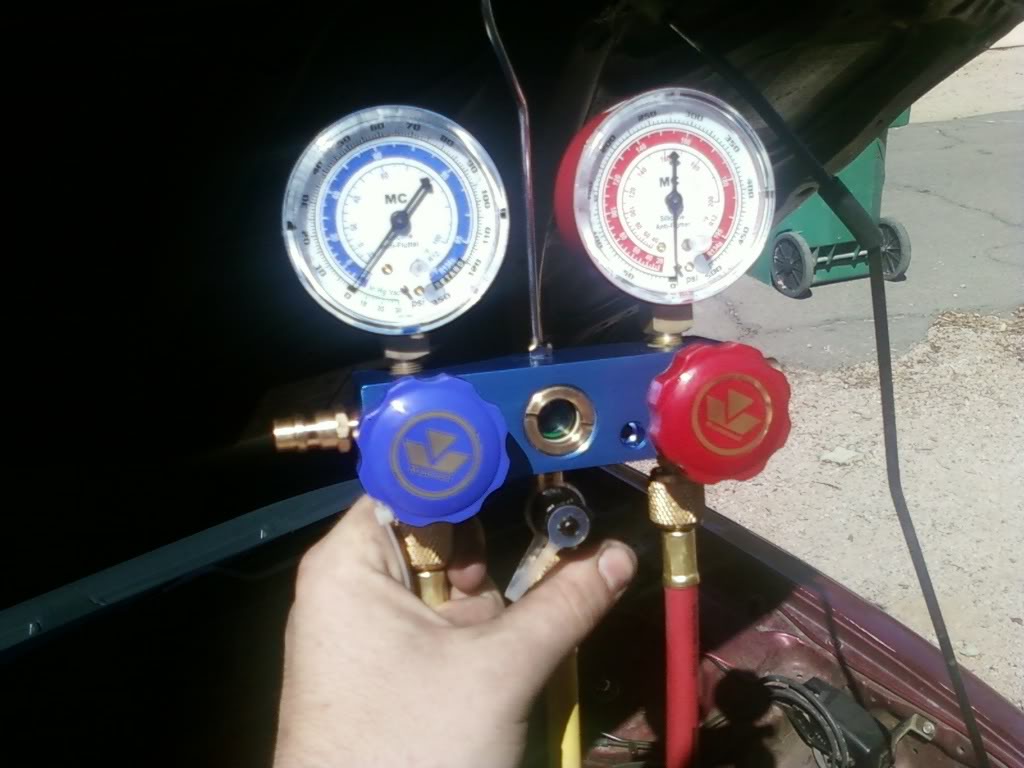
Also you will need a deep vacuum pump (able to draw at least 28 inches Hg of vacuum) equipped with a check valve. This prevents the vacuum pump oil from back-flowing into your system and damaging it.
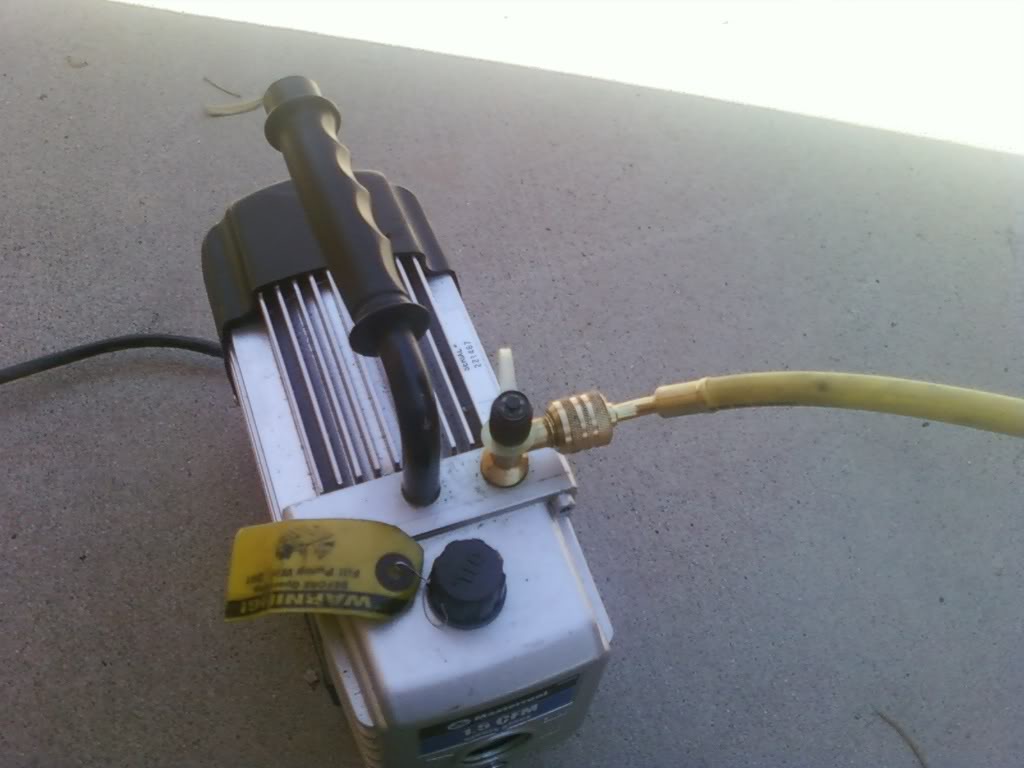
The third hose is currently connected to the vacuum pump (Read the instructions provided with the pump and familiarize yourself with its operation as not all are created equal)
Connect the high side and low side gauge hoses as shown. The plastic port caps unscrew and the hoses are quick disconnect fittings. You cannot mix up the hoses as the fittings are different sizes. They are universal to all vehicles so don't worry about the gauges fitting.
Before you connect the hoses make sure that both the high and low side valves on the gauge manifold are closed.
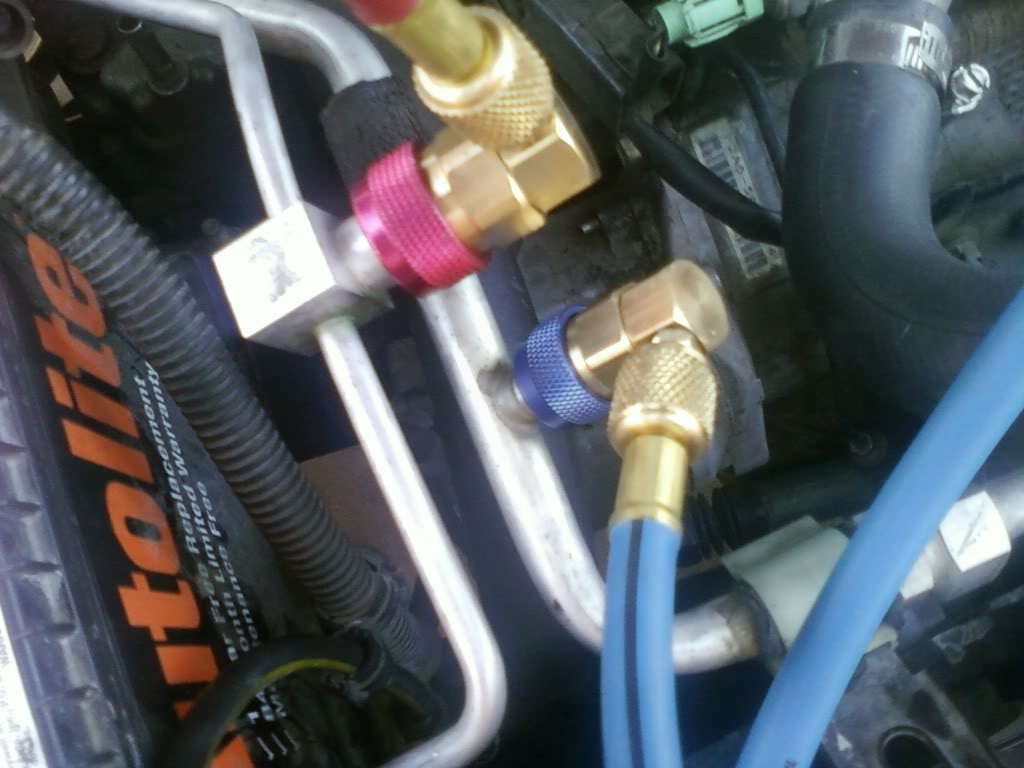
Once you have connected the fittings turn on the vacuum pump. Allow it to run for a minute or so. Then slowly open up the high and low side valves. It is important to do this slowly, otherwise the compressor oil will be drawn out of the system with the gasses. Allow the system to slowly be drawn down for about 15 minutes.
By this point you should have at least 28 inHg of vacuum. If you don't you have a leak. If you have reached this number open both valves all the way and allow the pump to run for another ten minutes.
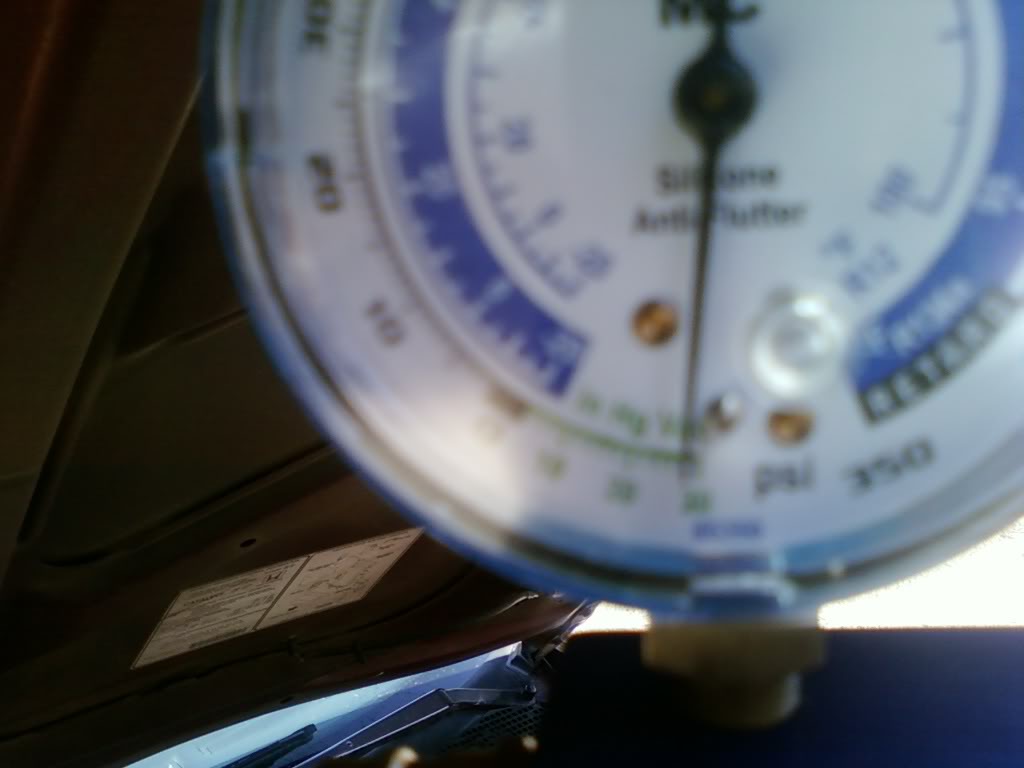
At this point close the high and low side pressure service valves, Turn off and disconnect the vacuum pump and allow the system to sit for at least ten minutes. I allowed mine to sit overnight. It should hold that vacuum. If the system begins to lose vacuum, you have a leak. Go find it.
If you don't have a leak reconnect the pump and continue pumping for at least 20 minutes. It is important that all the moisture and gasses are removed from the system.
Before charging look up your system capacity for refrigerant. Do not overcharge, you may damage your compressor. For CD accords built 1994-1995 it is: 22.9 oz +0/-1.8oz or metric: 650 +0/-50 grams of R134a. for those unfamiliar with tolerances that means that you can charge the system up to 50 grams/1.8 oz less than capacity and still have it function but not over.
Unfortunately the smallest amount of refrigerant I could buy was 12oz. So I bought two twelve oz cans. (340 grams)
Once you have finished evacuating the system, close both service valves and disconnect the vacuum pump. Start the engine, and switch the air conditioning on to MAX A/C. Some cars have a button, CD accords have the fan at 4 and the recirculation mode active.
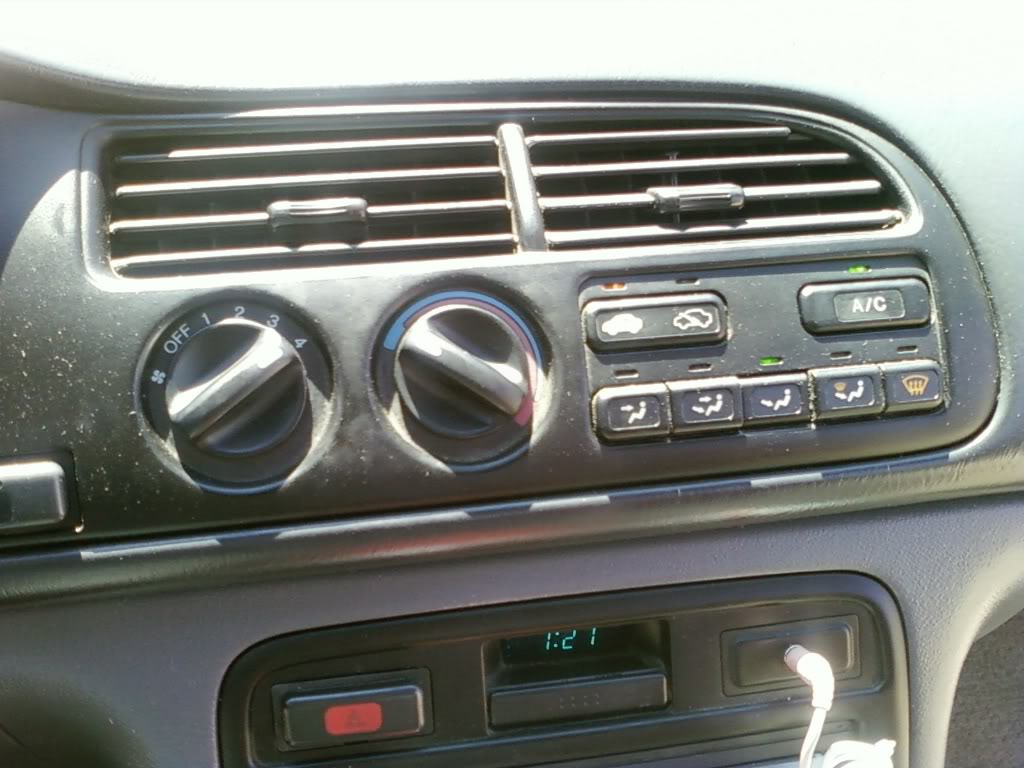
Now connect the can of refrigerant to the hose and open that valve on the can. Leave the service valves closed.
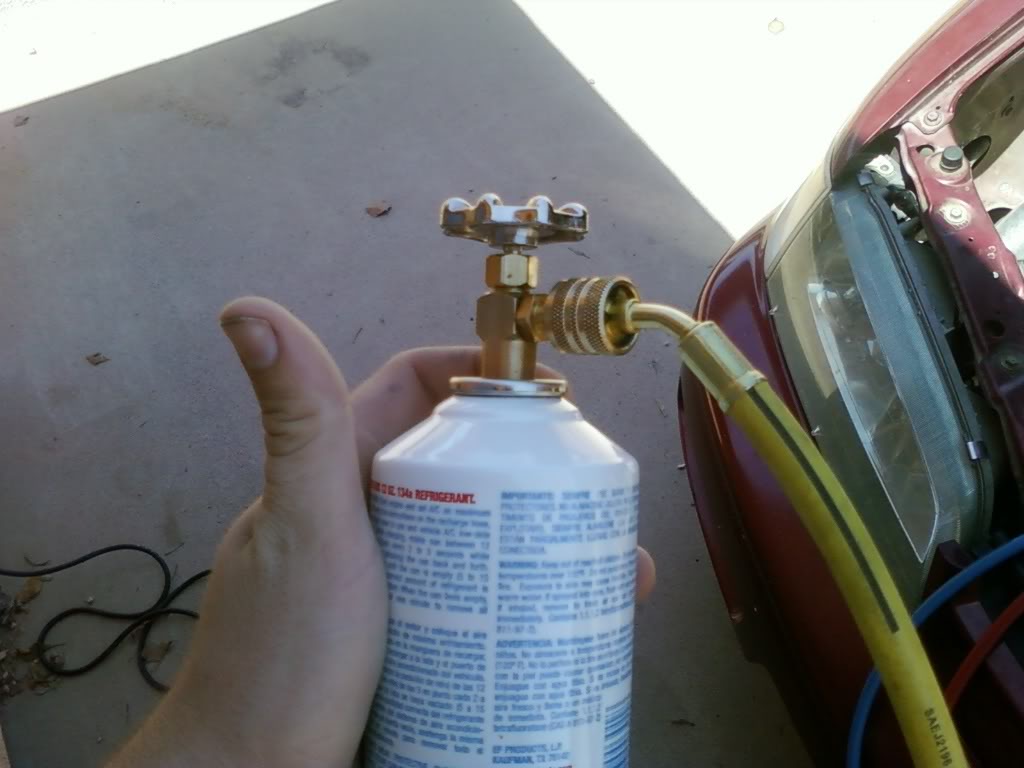
Once you have connected the refrigerant source to the gauge manifold slowly open the blue low side valve. Do not initially allow the refrigerant to enter the system at over 40 PSI. Watch the sight glass in the manifold for bubbles. You should see liquid and gas, but if it starts foaming and bubbling you are charging too fast. Shake the cans while you are doing this.
The system will not switch on until the pressure in the low side line gets above the cutoff pressure. When this happens the compressor will begin to cycle and the fans will come on. You can now begin to allow the refrigerant into the system at a faster rate.
When switching cans be sure that the can has been completely discharged. Then close the low side valve, close the can valve and SLOWLY begin to unscrew the can. Some refrigerant will escape as a gas. This is unavoidable. Do not inhale it. Repeat the charging procedure with as many cans as you need until full.
After the first can you can begin to allow the system pressures to exceed 40 PSI low side. However do not allow the low side pressure to exceed the maximum pressure listed on the pressure charts for your system.
I charged the system until I felt that it had been filled with refrigerant within tolerances. Do the same. Remember its ok to be a little under.
At this point close the tank valve. And allow the remaining refrigerant in your gauge manifold to be drawn into the system as much as possible. Then close the low side pressure valve. Disconnect the tank from the setup with the valve still in place. Connect your gauge manifold to the vacuum pump and evacuate it. (both high and low side valves open). You are done charging the system. Replace the dust caps and shut off the car.
The following procedure for disposing of leftover refrigerant is as follows. Take your can to the nearest auto shop that does HVAC work. Hand the tech the can and explain you have leftover refrigerant that you will not use. they should be happy to take if off your hands for free, if they try and charge you find someone else. Come back in a half hour to collect the valve. Return your tools and enjoy cold a/c.
Questions/comments welcome. If I have missed something tell me and I will add it.
Air conditioning systems are not something to be toyed with. Read and familiarize yourself with the operating principles of air conditioning systems, and also familiarize yourself with your vehicles system specifically as well as the legal ramifications of the system. If you are unsure take it to a professional.
Air conditioning systems operate at pressures from 60-30 PSI on the low side, and 300-450 PSI on the high side. I have had enough experience working with high pressure air systems (paintball guns if you must know) and these are not things to take lightly.
**** LEGAL DISCLAIMER****
I am not vehicle HVAC certified in any way. I am not to be held responsible for any personal loss or other consequences from following, or failing to follow these procedures. This includes, but is not limited to personal injury, legal consequences from improper handling of refrigerant, or damage to your vehicle of any kind, whether as a direct or indirect result of the following information. By reading and/or following these instructions you agree to the above statements and waive me of any responsibility.
I am performing this procedure after replacing the evaporator in my air conditioning system. The leak was a large leak, and as a result all of the refrigerant had escaped my system before I opened it. Always test your system for refrigerant before performing this procedure. If there is pressure have it professionally recovered before working on it.
DISCHARGING REFRIGERANT OF ANY KIND INTO THE ATMOSPHERE IS A FEDERAL OFFENSE
That being said don't do it.
Before you can perform this procedure properly you will need to obtain two items. I rented mine (Loan a tool) from autozone. You need to rent/borrow/buy an air conditioning manifold gauge set specific to refrigerant R134a (Do not mix fittings/hoses that have been used with R12, as it chemically decomposes the PAG compressor oil.)

Also you will need a deep vacuum pump (able to draw at least 28 inches Hg of vacuum) equipped with a check valve. This prevents the vacuum pump oil from back-flowing into your system and damaging it.

The third hose is currently connected to the vacuum pump (Read the instructions provided with the pump and familiarize yourself with its operation as not all are created equal)
Connect the high side and low side gauge hoses as shown. The plastic port caps unscrew and the hoses are quick disconnect fittings. You cannot mix up the hoses as the fittings are different sizes. They are universal to all vehicles so don't worry about the gauges fitting.
Before you connect the hoses make sure that both the high and low side valves on the gauge manifold are closed.

Once you have connected the fittings turn on the vacuum pump. Allow it to run for a minute or so. Then slowly open up the high and low side valves. It is important to do this slowly, otherwise the compressor oil will be drawn out of the system with the gasses. Allow the system to slowly be drawn down for about 15 minutes.
By this point you should have at least 28 inHg of vacuum. If you don't you have a leak. If you have reached this number open both valves all the way and allow the pump to run for another ten minutes.

At this point close the high and low side pressure service valves, Turn off and disconnect the vacuum pump and allow the system to sit for at least ten minutes. I allowed mine to sit overnight. It should hold that vacuum. If the system begins to lose vacuum, you have a leak. Go find it.
If you don't have a leak reconnect the pump and continue pumping for at least 20 minutes. It is important that all the moisture and gasses are removed from the system.
Before charging look up your system capacity for refrigerant. Do not overcharge, you may damage your compressor. For CD accords built 1994-1995 it is: 22.9 oz +0/-1.8oz or metric: 650 +0/-50 grams of R134a. for those unfamiliar with tolerances that means that you can charge the system up to 50 grams/1.8 oz less than capacity and still have it function but not over.
Unfortunately the smallest amount of refrigerant I could buy was 12oz. So I bought two twelve oz cans. (340 grams)
Once you have finished evacuating the system, close both service valves and disconnect the vacuum pump. Start the engine, and switch the air conditioning on to MAX A/C. Some cars have a button, CD accords have the fan at 4 and the recirculation mode active.

Now connect the can of refrigerant to the hose and open that valve on the can. Leave the service valves closed.

Once you have connected the refrigerant source to the gauge manifold slowly open the blue low side valve. Do not initially allow the refrigerant to enter the system at over 40 PSI. Watch the sight glass in the manifold for bubbles. You should see liquid and gas, but if it starts foaming and bubbling you are charging too fast. Shake the cans while you are doing this.
The system will not switch on until the pressure in the low side line gets above the cutoff pressure. When this happens the compressor will begin to cycle and the fans will come on. You can now begin to allow the refrigerant into the system at a faster rate.
When switching cans be sure that the can has been completely discharged. Then close the low side valve, close the can valve and SLOWLY begin to unscrew the can. Some refrigerant will escape as a gas. This is unavoidable. Do not inhale it. Repeat the charging procedure with as many cans as you need until full.
After the first can you can begin to allow the system pressures to exceed 40 PSI low side. However do not allow the low side pressure to exceed the maximum pressure listed on the pressure charts for your system.
I charged the system until I felt that it had been filled with refrigerant within tolerances. Do the same. Remember its ok to be a little under.
At this point close the tank valve. And allow the remaining refrigerant in your gauge manifold to be drawn into the system as much as possible. Then close the low side pressure valve. Disconnect the tank from the setup with the valve still in place. Connect your gauge manifold to the vacuum pump and evacuate it. (both high and low side valves open). You are done charging the system. Replace the dust caps and shut off the car.
The following procedure for disposing of leftover refrigerant is as follows. Take your can to the nearest auto shop that does HVAC work. Hand the tech the can and explain you have leftover refrigerant that you will not use. they should be happy to take if off your hands for free, if they try and charge you find someone else. Come back in a half hour to collect the valve. Return your tools and enjoy cold a/c.
Questions/comments welcome. If I have missed something tell me and I will add it.
#2
Thanks for the write-up.
I need to do something about my AC (6th gen Accord). It cycles on and off, and even when on, it's not very cold. Sometimes makes a hissing noise (heard inside the car) when it kicks in.
I bought the car used, and assuming the service records the seller gave me are complete, it looks like the only time anything was done to the AC was at the 70k mi. mark, 5 years ago (at 120k now). There was a leak on the high side, and they replaced the high side pressure line, performed evac and recharged the AC system, and after all that, the temp being blow out was 43*. The technician also noted the compressor was making noise and he recommended replacing the compressor as it may cause problems in the future. As far as I can tell, the prior owner never replaced the compressor.
I'm guessing the first step is to determine the temp of the air being blown through the vents and to determine the pressure at the high side and low side service valves. Sound about right? Anything else I should be looking or listening for that would help diagnose the problem?
I need to do something about my AC (6th gen Accord). It cycles on and off, and even when on, it's not very cold. Sometimes makes a hissing noise (heard inside the car) when it kicks in.
I bought the car used, and assuming the service records the seller gave me are complete, it looks like the only time anything was done to the AC was at the 70k mi. mark, 5 years ago (at 120k now). There was a leak on the high side, and they replaced the high side pressure line, performed evac and recharged the AC system, and after all that, the temp being blow out was 43*. The technician also noted the compressor was making noise and he recommended replacing the compressor as it may cause problems in the future. As far as I can tell, the prior owner never replaced the compressor.
I'm guessing the first step is to determine the temp of the air being blown through the vents and to determine the pressure at the high side and low side service valves. Sound about right? Anything else I should be looking or listening for that would help diagnose the problem?
#3
Here's a chart that should help those working on an AC system at high altitudes.
http://www.anver.com/document/vacuum...20pressure.htm
For example, at 5,000' elevation the best vacuum you could possibly achieve is ~ 25" Hg.
http://www.anver.com/document/vacuum...20pressure.htm
For example, at 5,000' elevation the best vacuum you could possibly achieve is ~ 25" Hg.
#4
I am having problems with my ac system in my cb9 accord, no more cold air. I was going to put more refrigerant in until I heard my old system doesn't accept R134a. So my question is: How can I know if my system has been converted over to the newer R134a refrigerant? If its not I just want get some R12 (which you can get at ebay).
#5
I am having problems with my ac system in my cb9 accord, no more cold air. I was going to put more refrigerant in until I heard my old system doesn't accept R134a. So my question is: How can I know if my system has been converted over to the newer R134a refrigerant? If its not I just want get some R12 (which you can get at ebay).
Not sure what year your car is.
If it came OE with r-12 and has/was converted properly- look at the fittings for the high and low side ports. The fittings between an r12 and r134 are different.
Thread
Thread Starter
Forum
Replies
Last Post
Tyler Dirden
Honda Civic / Del Sol (1992 - 2000)
11
02-07-2015 10:12 AM
ZC88CRX
Honda CRX / EF Civic (1988 - 1991)
2
01-02-2004 05:12 PM
manveer
Road Racing / Autocross & Time Attack
13
02-25-2002 09:58 AM
2002, ac, accord, air, car, conditioning, evacuate, evacuation, hand, honda, pressures, pump, recharge, recharging, vacuum






